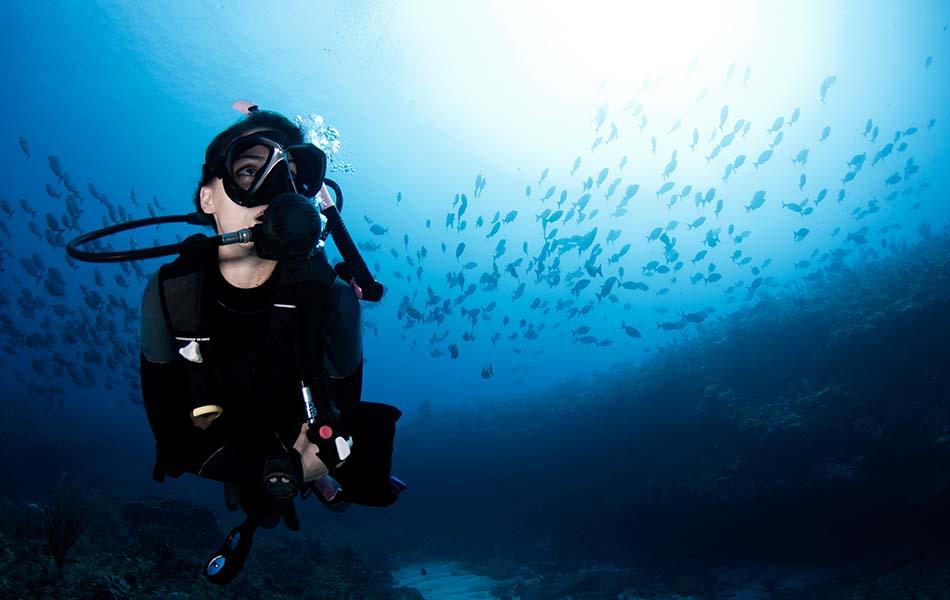
Dr Ashley Davies reports on the musculoskeletal structure of our bodies, and how we divers need to look after our ‘dry bones’.
The adult skeleton contains approximately 206 bones which, together with the muscles, form the musculoskeletal system. Bones consist of a collagen mesh, onto which a complex of calcium and phosphate is deposited. This is woven into two different patterns to create a bone. On the exterior is hard, dense cortical bone. This gives the bone its smooth, white appearance and provides strength and rigidity. The core consists of porous, honeycomb-like bone to reduce weight and transfer forces from the joint surfaces to the cortical bone.
The skeleton has many functions including; supporting the tissues and organs of the body, working with the muscles to allow movement, and protecting the vital internal organs. The spaces within cancellous bone (the ‘inner’ variety) contain bone marrow which is responsible for blood cell production.
Osteoporosis and diving
Specialised cells in our body continuously resorb ‘old’ bone, while others deposit new bone. In growing children, more bone is deposited than resorbed. As we age, we begin to resorb more bone than we deposit, and our bones become softer and weaker. This may result in Osteoporosis.
Symptoms include bony fractures after a minor fall, loss of height and chronic back pain. Osteoporosis is more common after the age of 60, in women (particularly those with early menopause), smokers and those taking steroids.
Although there are no specific diving-related concerns, any fall would be more likely to result in a fracture, especially if wearing heavy dive kit. If you believe you may be at risk of osteoporosis, consult your GP who can investigate and commence treatment where required. This should not impact your fitness to dive, on the contrary, it will help you to avoid injury.
Fractures
Exposing a bone to a significant force, such as falling onto an outstretched hand, may break it. This is known as a fracture. To allow the bone to heal we must align the fragments and hold them together. This is commonly done using a plaster cast, but in some cases, the orthopaedic surgeons use clever metalwork to hold everything together.
Unfortunately, it will not be possible to dive while the bone is healing. Your mobility will be impaired, which may impact your ability to operate your equipment. There may also be a disruption in blood flow to the injured tissue; this can alter the uptake and release of gas, increasing the risk of DCI.
Once fully healed, a return to diving should be possible. If you experience any persisting pain, numbness or weakness you should first be examined by a diving doctor, as these symptoms can mimic DCI and confuse the diagnosis. A diving doctor will examine you and note any areas of weakness or altered sensation.
Dysbaric Osteonecrosis
Dysbaric Osteonecrosis (DON) is the destruction of bone due to the effects of increased ambient pressure, thought to be due to blockage of blood vessels by bubbles. It is more commonly seen in those conducting deep, bounce dives and is rare in those who dive shallower than 30m. It is also associated with:
- Total number dives (but can occur after a single exposure to pressure)
- Increased depth
- Extended bottom times
- History of DCI
- Obesity
Symptoms (and the associated lesion) appear many years after the initial injury and depend on the bone affected and where in the bone the lesion lies. Those affecting the shaft of the bone are usually asymptomatic, but if the lesion lies near a joint it can cause pain and reduced mobility. X-ray and/or MRI imaging may show lesions of the bone.
The risk of DON in sport divers is very low, but we may see an increase in this group as they venture ever deeper. Prevention is better than cure, so diving conservatively and avoiding aggressive decompression schedules will minimise risk. If you believe you may be affected, then seek the advice of a diving doctor.
Interested in diving health and medicine?
This column is produced with DDRC Healthcare, specialists in diving and hyperbaric medicine. You can find out more on their website.
This Anatomy of a diver column was originally published in SCUBA magazine, Issue 106 September 2020. For more membership benefits, visit bsac.com/benefits.
Images in this online version may have been substituted from the original images in SCUBA magazine due to usage rights.

 Author: DDRC Healthcare | Posted 14 Oct 2020
Author: DDRC Healthcare | Posted 14 Oct 2020



